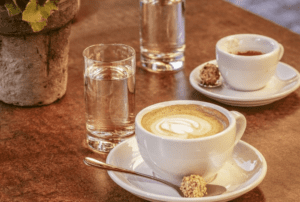“Shall we have a coffee?” in Italian: “Vuoi un caffe’?” A simple question that encompasses the desire to be together, to confide in one another, to relax, a break during work! The place can be “il bar” or simply at home! This is the first question that an Italian will ask you when welcoming you into his house, right after greeting you!
Typically, at home, coffee is brewed with the moka pot, a stovetop coffee maker. The “moka” consists of three parts, a lower part which is filled with water, a funnel-shaped filter filled with ground coffee, which will go on top of it, and finally an upper part that screws onto the lower one. The operating principle is pretty straightforward: once put on the stove, the water will boil up and will pass through the filter, thus brewing the drink from the ground coffee, that will be collected in the upper part of the machine.


This is what many refer to as “caffe’ normale”. It can have different levels of intensity depending on the ratio between water and ground coffee. At the “bar”, however, the typical “un caffè, per favore” corresponds to what is commonly known as “espresso”, it is served in small quantity (less than 50ml) since the amount of water used is much less compared to moka, the brewing mechanism is similar to the moka, but the water is pushed through the coffee powder at a much higher pressure; this gives to the espresso a very intense and rich taste.
In addition to espresso, there are numerous variations of coffee that you can try at the bar: “decaffeinato” (decaf), “macchiato” (an espresso coffee with little milk on top), “cappuccino” (an espresso coffee mixed with about 150ml of milk, half of which is foam form); “latte macchiato” (an espresso mixed with about 150ml of whole fat milk); “marocchino” (espresso coffee plus equal amount of milk and bitter cocoa powder sprinkled on top).
Very popular, especially during summer, are “caffè shakerato” (espresso, sugar, ice and some milk) and “crema di caffè” (espresso, fresh cream, sugar, cocoa powder and coffe beans on top). But that’s not all, there is the “caffè corretto”, “caffè ginseng” and many more. American coffee? No, thanks, not that popular in Italy to say the least, it is considered too watery and without character.
But how did coffee arrive in Italy? What are its origins? Coffee has a long history, it had been discovered in Ethiopia by pure chance. A shepherd, who was grazing his goats, noticed a strange behavior in some of these during the night: they were strangely full of energy. The shepherd attributed this behavior to the plant that his goats had eaten while grazing, which had berries in it. Hence the discovery that the infusion of roasted and ground seeds had an energizing effect. The consumption of this drink dates back to the 15 th century, in Yemen. In the 17 th century it was already spread worldwide.
It was quite expensive initially, due to its rarity. It was later produced in France, Holland, Cuba, Venezuela and in the 21 st century it has been the most traded product in the world, second only to oil. Coffee reached Italy in 1750 in Venice, initially sold in pharmacies. In a short time the famous “botteghe del caffè’” were born. A very expensive drink at the time and therefore a privilege only for the wealthiest people, but it was so successful that “botteghe del caffè”, in the second half of the 1700s, were already more than 200. The spread of this product made this drink increasingly popular and less expensive, thus becoming the drink that above all is synonymous with conviviality. The success of coffee was mainly due to its exciting effect, but it is precisely for this same reason that it was initially banned by the Church and it had to wait until the 18th century, thanks to Illuminism, to clean up its bad reputation. But why does coffee cause this state of excitement and well-being? It is thanks to the presence of a substance called “caffeine”, which reduces fatigue and has an energising effect, improves mood, attention, helps with digestion, reduces the appetite and promotes weight loss as it burns fat for energy and thermogenesis.
Be careful with the quantities though as too much of it can have opposite effects.
In Italy, refusing to have coffee with someone is almost considered offensive. In a well-known Italian movie, titled “Benvenuti al sud” it is shown that refusing coffee when offerend is basic impossible it is to refuse a coffee at an Italian’s home ..
Especially in the south of the country. So remember: never say no to coffee. Just kidding… or maybe not.
